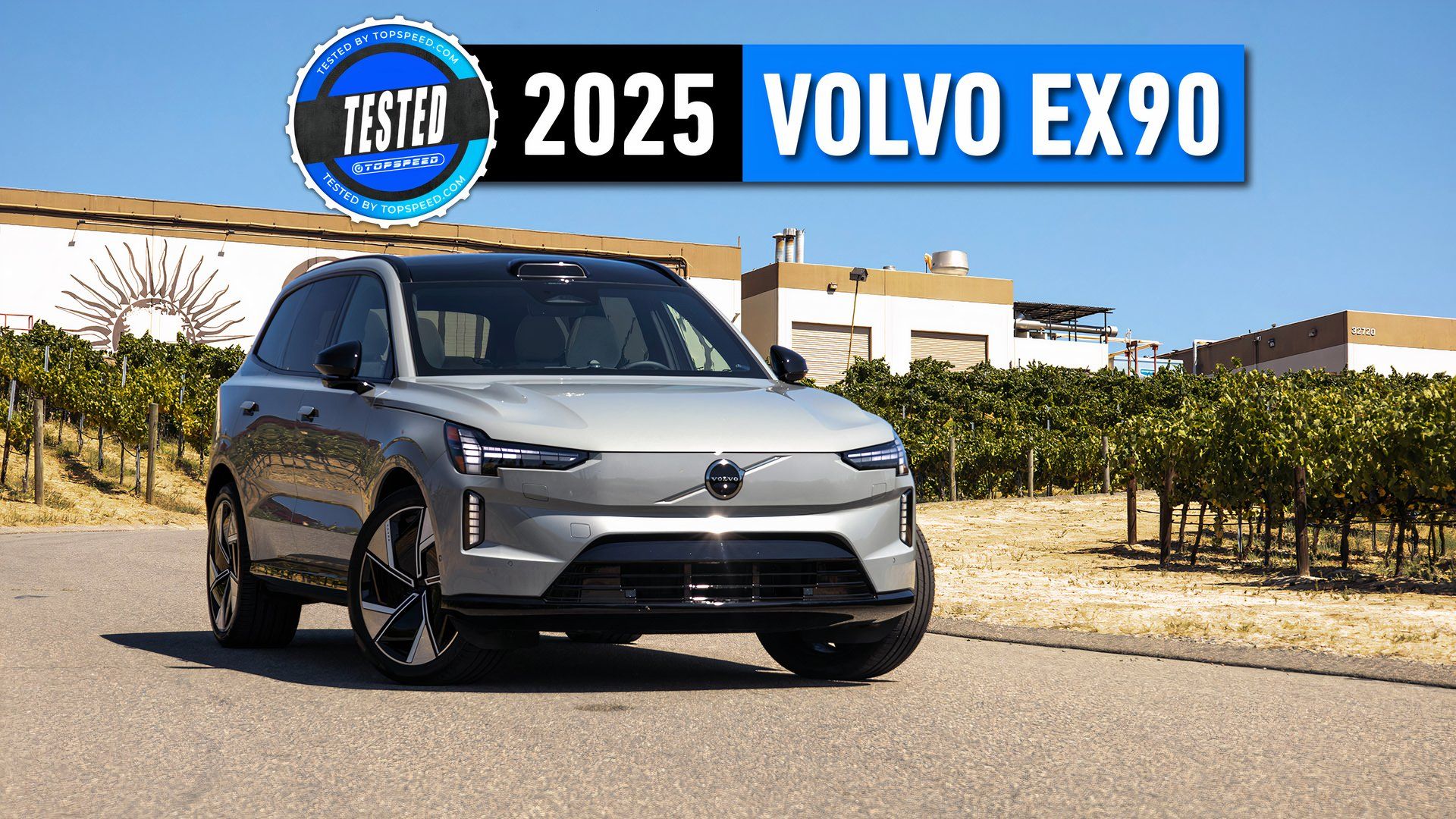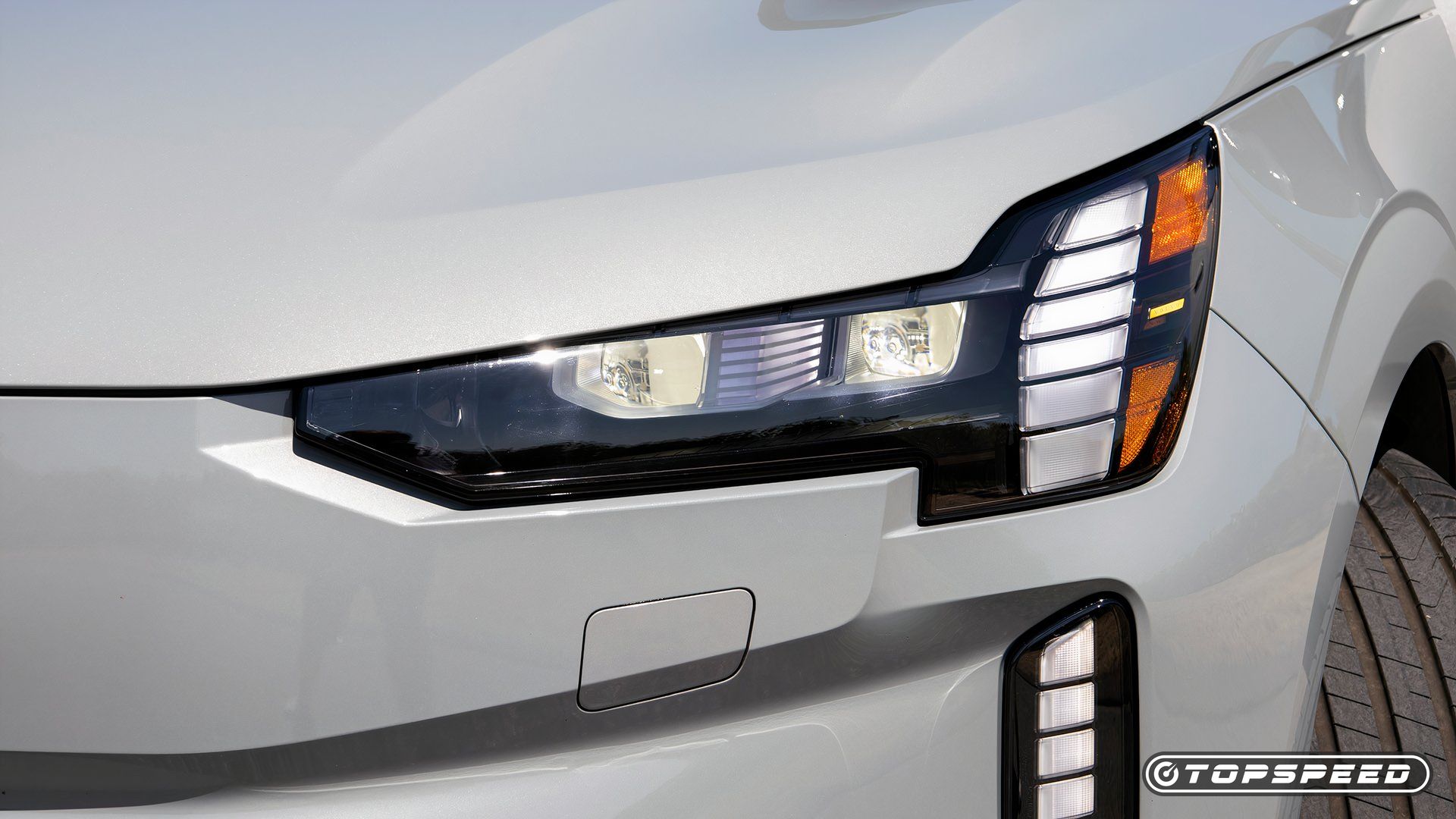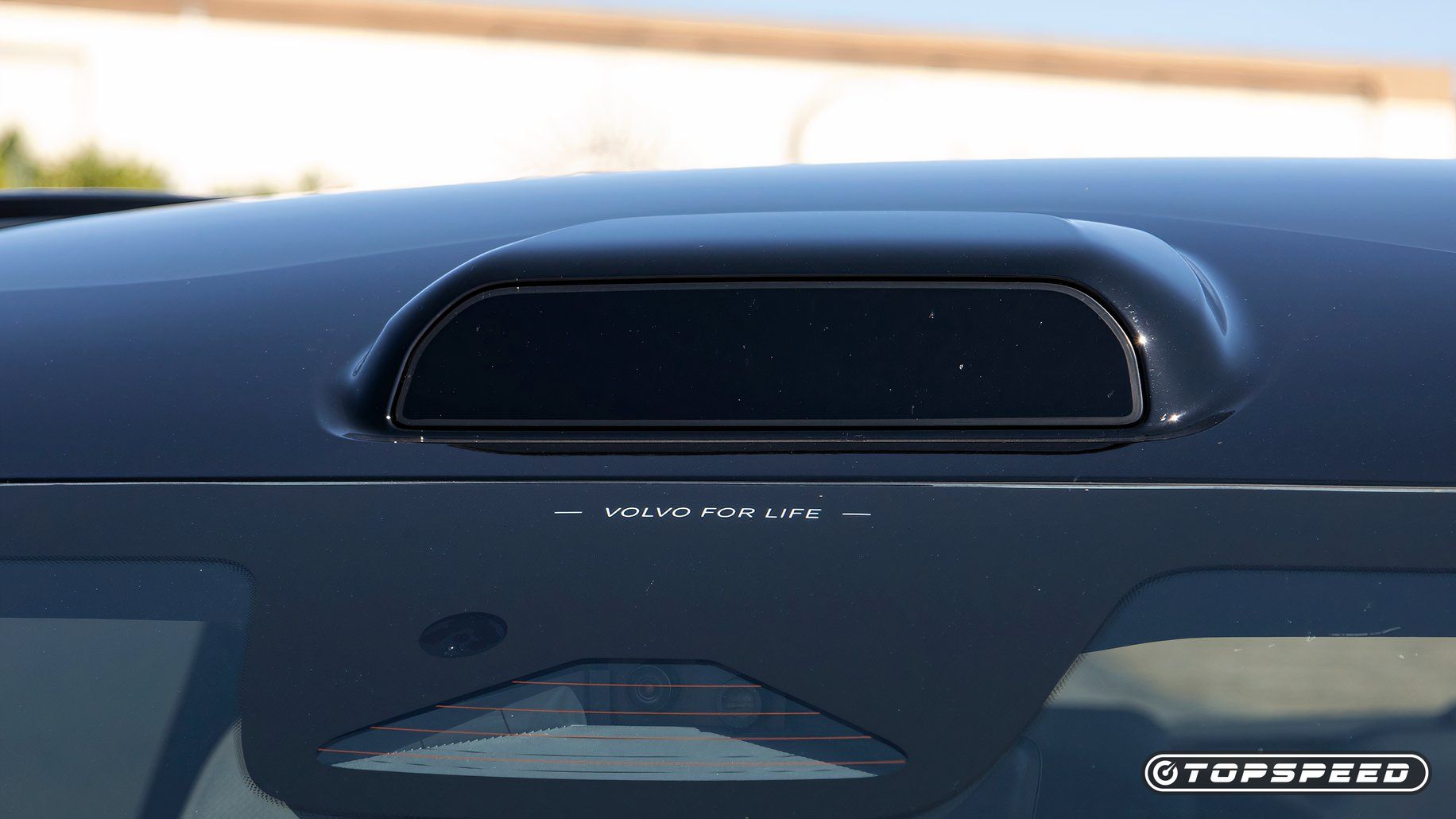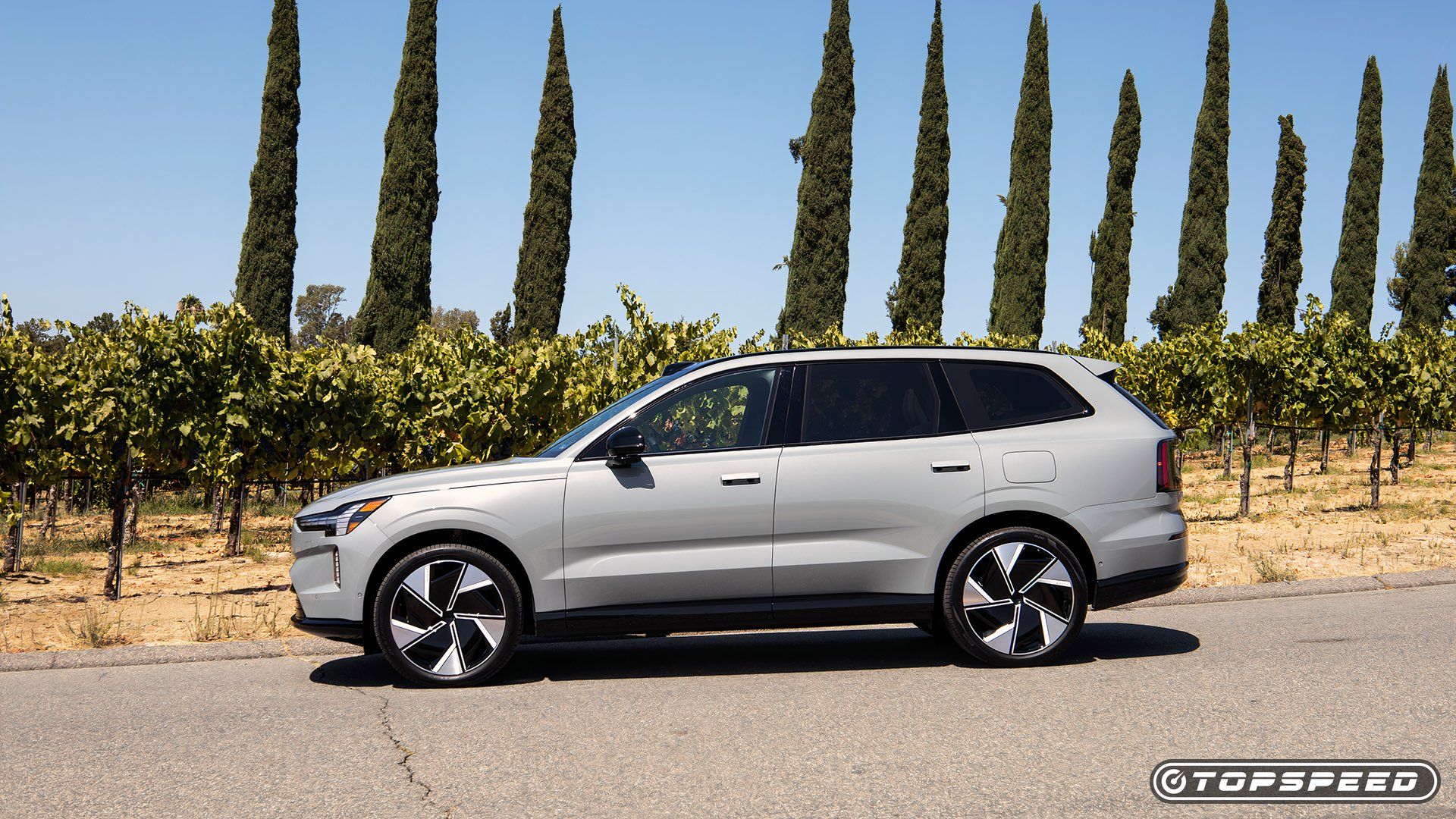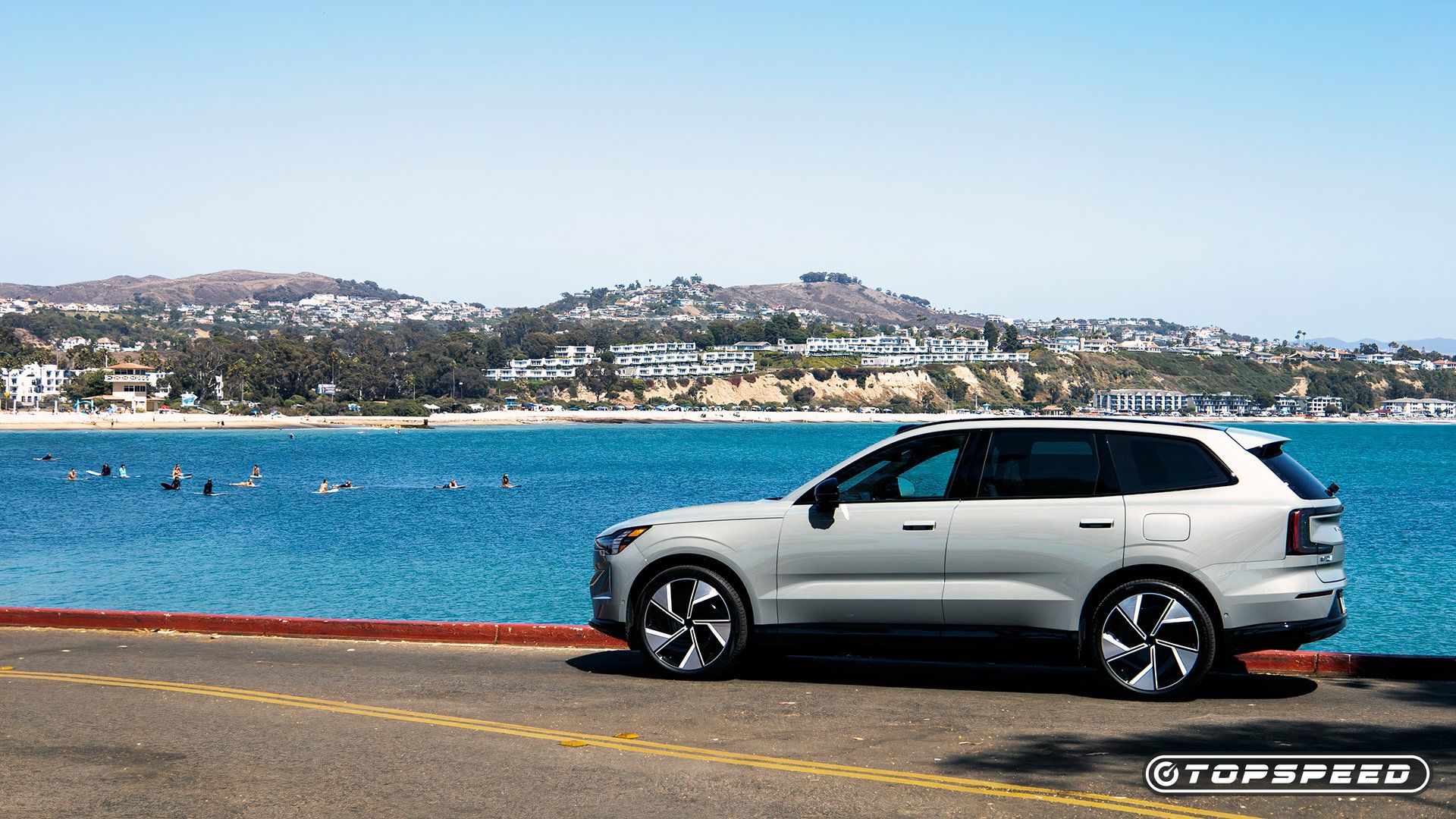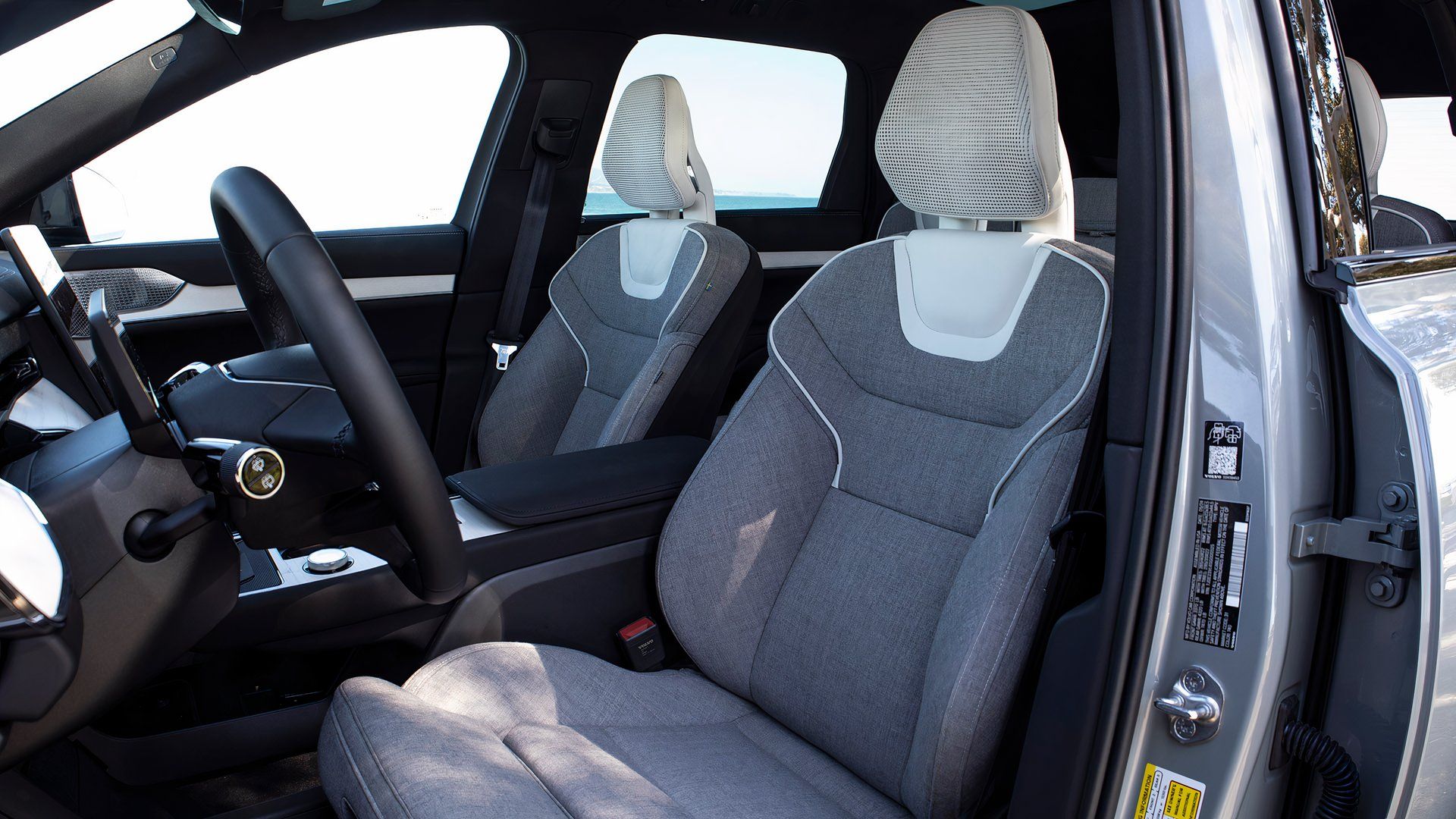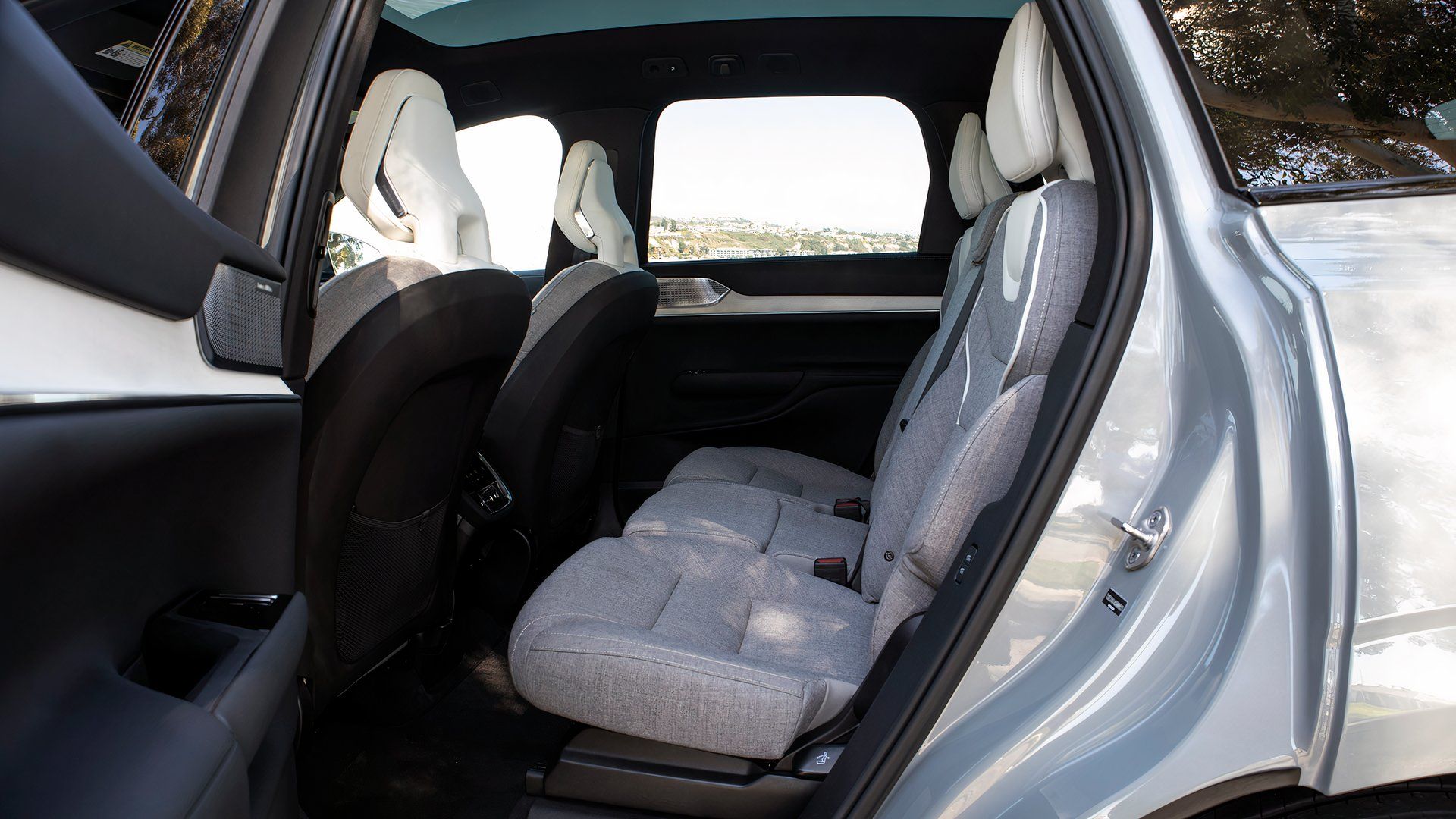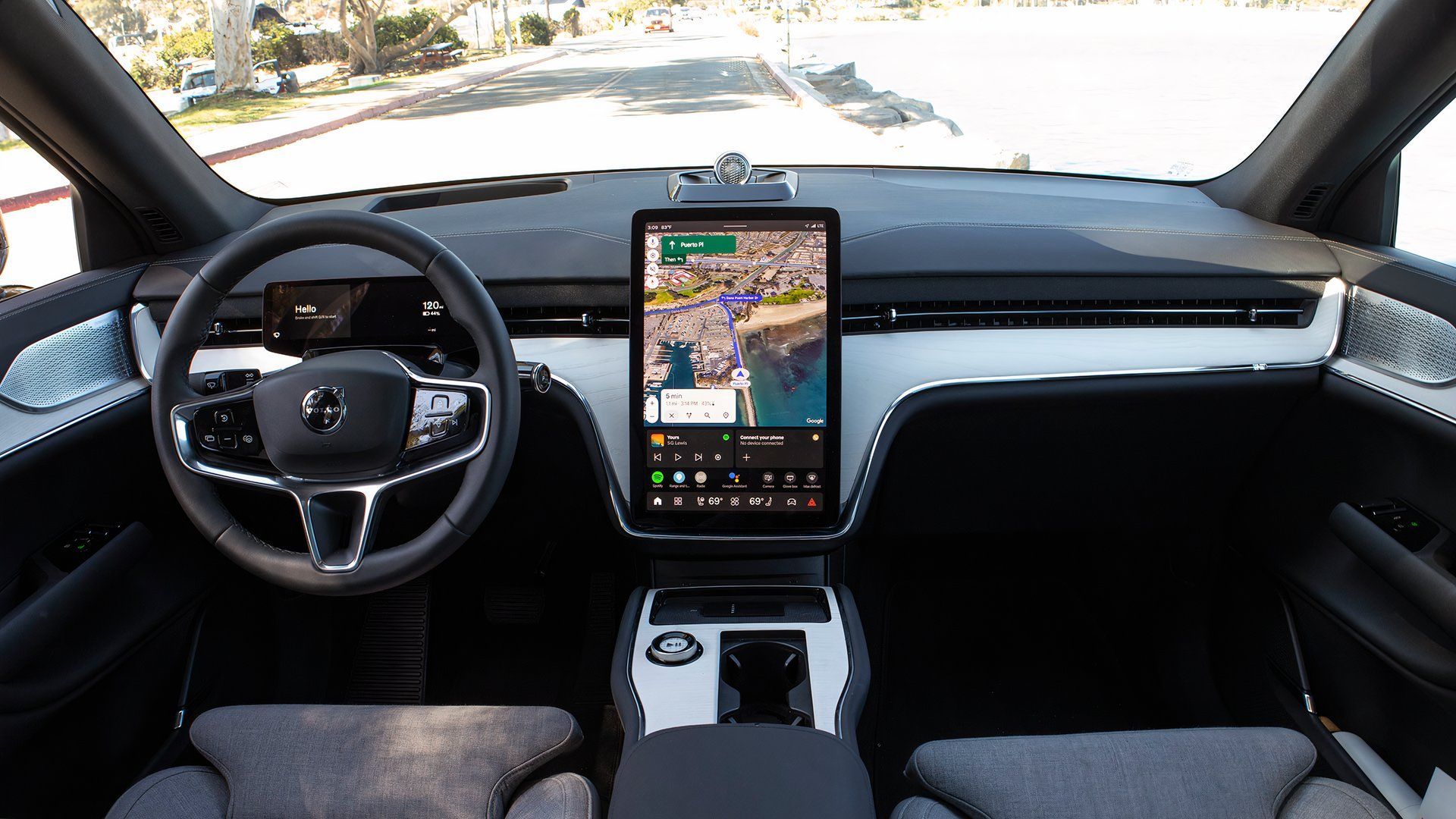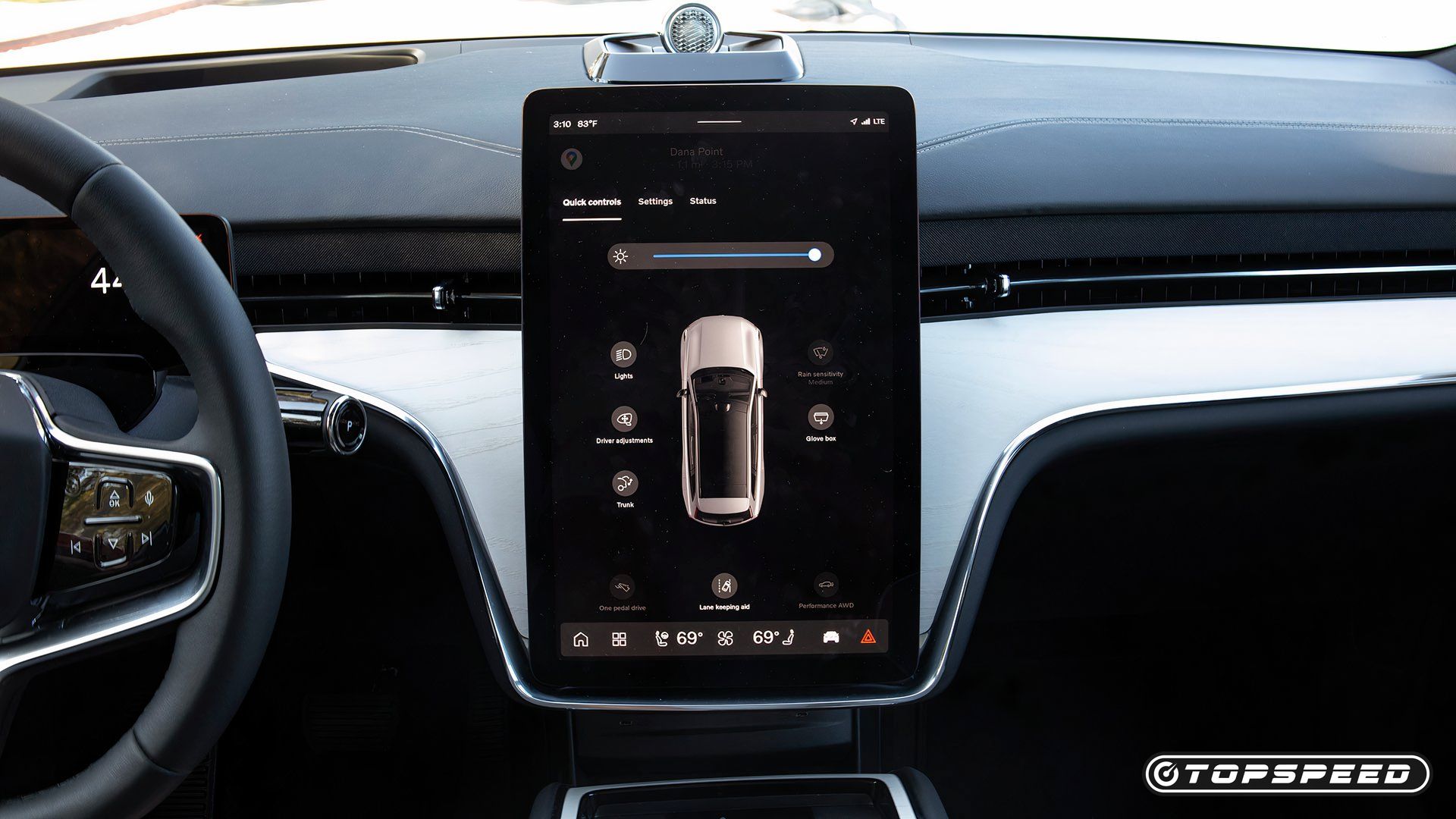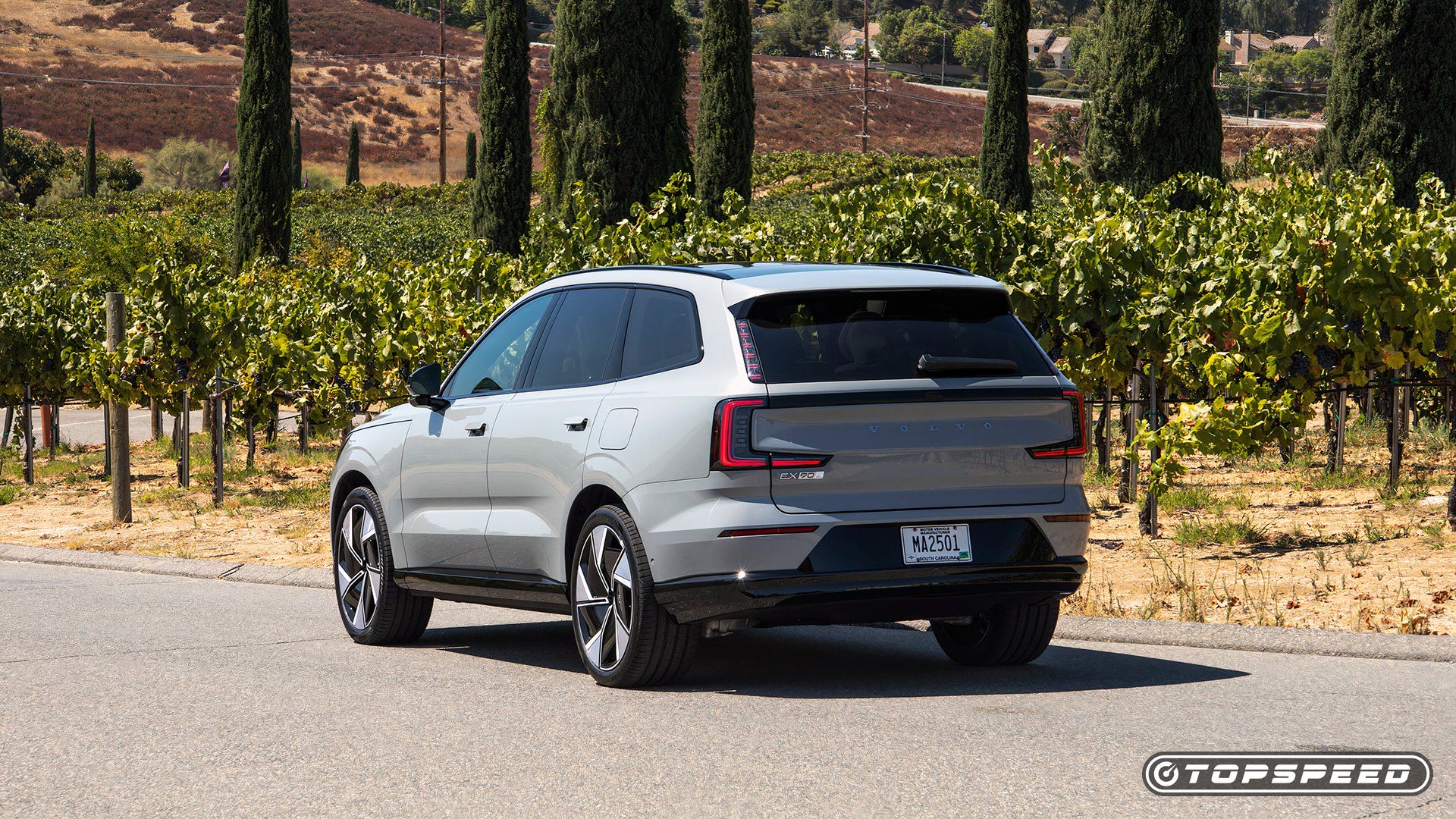Summary
- The electric EX90 offers familiar looks, good build quality, smooth ride, and impressive range.
- Despite software glitches, tight third-row seating, and limited cargo space, the EX90 has potential.
- The EX90 differentiates itself with Scandinavian design, advanced autonomous driving tech, and a smooth driving experience.
It’s been almost two years since I flew to Sweden to see the EX90 in the flesh, Volvo‘s first-ever fully electric three-row SUV, a vehicle expected to one day replace the XC90 flagship.
Back then, the carmaker spoke of a 2024 model, but hadn’t shared a specific release date. The EX90 would ride on an all-new, electric vehicle (EV) dedicated platform provided by Geely, offer class-competitive range and charging performance, and, perhaps more importantly, integrate Volvo’s next generation Pilot Assist autonomous driving technology, all backed by a fancy new lidar provided by Luminar Technologies, and a powerful NVIDIA processor capable of artificial intelligence. It all seemed very promising.
But then, the EX90 was delayed, and delayed again due to a mixed bag of manufacturing issues and legislation towards Chinese-built vehicles. Sure, Volvo had announced that the EX90 would eventually be built in Charleston, South Carolina, but the original plan was to first send us Chinese-built examples. That was all thwarted by the Biden administration’s strict importation tariffs.
Here it is at last, a preproduction version of one of Volvo’s most important vehicles in over a decade for us journalists and content creators to review. I’m here to tell you that, yes, the EX90 has the potential of disrupting the large premium electric SUV space, but it still needs a bit of work to get there.
Volvo Canada flew me to California, fed me, paid for my hotel and loaned me a 2025 EX90 preproduction unit to review. I did not live with the vehicle during a full week like I usually do for these reviews. For detailed insight into testing procedures and data collection, please review our methodology policy.

2025 Volvo EX90
Contrary to popular belief, the EX90 electric SUV is not replacing Volvo’s XC90 flagship. At least, not yet. It’ll be sold alongside it as Volvo’s first fully electric large SUV offering. The EX90 distinguishes itself from other vehicles of this segment through its clean, Scandinavian design and advanced autonomous driving technology powered by artificial intelligence.
- Familiar Volvo looks with impeccable build quality.
- Smooth-riding, quick off the line and supremely comfortable.
- Class-leading (advertised) range and charging performance.
- Several software glitches were observed.
- Third row seating is a tight squeeze, and cargo space is on the down side.
- Not cheap.
2025 Volvo EX90 First Impressions
Looks have always been something the Scandinavian carmakers have excelled at, and the EX90 is no exception. While it may appear like it hasn’t really changed over the XC90, the EX90 is in reality a clean sheet design. Nothing on this SUV is shared with its predecessor, revealing just how well Volvo masters evolutionary design.
The EX90 looks clean, mature, elegant and sophisticated. Yet, it’s also understated, never attracting too much attention to itself as it humbly blends within the automotive landscape. Volvo, rather, uses paint colors and wheel designs to accentuate the EX90’s shape and stance, further highlighting its position as a boutique automaker.
My personal favorite design elements are the neatly integrated pop-up headlights behind the Thor’s Hammer LED daylight running lights (DRLs). Their operation not only looks cool as heck, but they actually change the car’s front fascia, giving it near human-like characteristics.
That’s because Volvo wants you to see the EX90 as a companion for your next journey, a vehicle that learns about you and its environment over time. This emphasis on self-improvement is immediately reflected in the EX90’s design through the large lidar that pops out of the top of the windshield like a wart.
Volvo could have found a way to hide it in order to blend with the EX90’s otherwise uncluttered styling, but it says the lidar is visible for a reason, to highlight the autonomous driving technology it’s been busy developing. I’ll get back to all that in a bit.
I really like the way this vehicle looks. It’s typically Volvo and typically Scandinavian in the most minimalist possible approach, an oxymoron considering it’s all been grafted onto a large SUV. Perhaps, more importantly, is the fact that the EX90’s styling is never offensive. Like all Volvos that came before it, it is guaranteed to age beautifully.
Exterior Dimensions
|
Length |
198.3 in. |
|
Width (With Mirrors) |
77.3 in. |
|
Height |
68.8 in. |
|
Wheelbase |
117.5 in. |
|
Front Track |
65.8 in. |
|
Rear Track |
65.6 in. |
|
Curb Weight |
6,058 lb. |
2025 Volvo EX90: Differences Between The U.S. And Canadian Market
Both in the U.S. and Canada the EX90 is sold in two available trim levels, Plus and Ultra. And in both cases, the vehicle comes standard with dual motor all-wheel drive and identical technical specifications. Wheel and color options are also the same, and in both markets, the vehicle is available in either a six or seven passenger layout.
|
U.S. Market |
Canadian Market |
|
EX90 Plus ($81,290 USD) |
EX90 Plus ($110,600 CAD) |
|
EX90 Ultra ($85,640 USD) |
EX90 Ultra ($116,200 CAD) |
Driving Impressions And Performance
My time with the EX90 was spent behind the wheel of a fully-loaded Ultra model. We were given the opportunity to drive from Long Beach towards Lake Elsinore, and then back alongside the pacific coast on picturesque California Route 1.
All versions of the EX90 are powered by the same liquid-cooled, lithium-ion battery good for 111 kWh nominal (107 kWh usable). It powers two permanent magnet electric motors (Volvo E400V13) good for a total combined output of 510 horsepower and 671 lb-ft of torque, allowing this 6,000-pound behemoth to sprint from 0 to 60 mph in just under five seconds.
But out there in the open, the EX90 never snaps your head into the headrest like most EVs do. Instead – very much like the smaller EX30 I drove last year in Barcelona – it delivers its performance in a more linear and progressive manner, an unusual feeling in this age of instant-reacting EVs.
It also rides smooth and soft, another oddity given the vehicle’s ridiculous weight and available 22-inch wheels (as tested). The suspension reacts well to bumps and road imperfections, while the entire cabin is vault-quiet at all times, further driving the point home that Volvo remains a premium brand.
Handling is also impressive considering how tall and not performance-oriented the EX90 is. This large SUV is sure-footed, stable and provides tons of grip to catapult itself out of a corner. A small-diameter steering wheel further accentuates this sensation of being in control of the machine, but don’t expect that digitally-connected wheel to provide any form of feedback about what the front wheels are doing.
One pedal driving can be activated through the infotainment system. There’s also Auto mode which, apparently, takes care of the regenerative braking for you based on your driving habits. But I never once felt the system engage while using it. I’ll need to live with the EX90 longer to properly test this feature.
Performance Specifications
|
Battery Type |
Liquid-cooled, Lithium-ion |
|
Battery Capacity |
111 kWh Nominal (107 kWh Usable) |
|
Driveline |
Dual-Motor AWD |
|
Horsepower (Combined) |
510 HP |
|
Torque (Combined) |
671 LB-FT |
|
0-60 MPH |
4.9 Seconds |
|
Towing Rating |
4,850 LB |
2025 Volvo EX90 Energy Consumption And Range
The EPA hasn’t yet published official energy consumption numbers and range for the EX90, but Natural Resources Canada did publish them with different wheel sizes. It varies between 2.8 and 2.9 Le/100 km, or between 84 and 81 MPGe. Volvo claims between 300 and 310 miles of driving range.
Charging on a fast-charging level 3 unit is claimed by the carmaker at an industry competitive 250-kW, which is on par with all current Teslas and even the Hyundai group’s E-GMP-based EVs. This equates to a 20 to 80% charge in around 27 minutes. The onboard charger for home level 2 charging is set at 11 kW, or about 12 hours for a full charge. The EX90 is also compatible with bidirectional charging, allowing it to redistribute electricity back into your home, the grid or to power accessories provided you purchase the required equipment to do so.
Unfortunately, since I drove the EX90 in a manufacturer-controlled environment and for a short period of time, I was unable to evaluate real-world consumption, range and charging. I’ll need to live with a press unit in my neck of the woods for a full week to do that.
EPA, Natural Resources Canada And As Tested Energy Consumption (22-inch Wheels)
|
City |
Highway |
Combined |
|
|
EPA Energy Consumption |
NA |
NA |
NA |
|
Natural Resources Canada Energy Consumption |
2.8Le/100 km |
3.0 Le/100 km |
2.9 Le/100 km |
|
Energy Consumption As Tested |
NA |
NA |
NA |
Interior Design And Comfort
Volvo’s minimalist approach is carried over inside the EX90 where the carmaker basically removes as much hardware and buttons as possible, for better or for worse.
For starters, Volvo’s expected build quality and attention to detail can be found in every facet of the EX90, from the quality of its paint, to how solid and long-lasting everything feels.
Comfort is also an area Volvo has always excelled in, and the EX90 is no exception. Seats look and feel like sport bucket seats that would belong in a sports car, with a ton of bolstering, lumbar and even massaging features. But I do need to warn you that if you’re – ahem – horizontally challenged like yours truly, the Swedes will quickly remind you that you need to hit the gym. The EX90’s seats always feel like they’re squeezing your love handles.
But those seats also look like a million bucks thanks, again, to the slick Scandinavian design and neat, sustainable materials. There’s no dashboard per se, but rather a large, Tesla-like tablet display (more on that later), as well as a smaller digital instrument readout. It’s all clean and non-offensive in there thanks to a clever use of warm materials, cabin lighting and color combinations.
Second row leg and headroom are also more than sufficient for a tall passenger. Even sitting behind a front seat that had been adjusted for my size, I was able to find comfort back there, while the dome-like panoramic roof gave way to a generous amount of headroom. That all being said, just like in the XC90, third row seating and access is tight and should rather be reserved for children.
Back to Volvo’s obsessive quest to remove buttons. It does come at a price at times, like when lowering the rear windows from the driver’s seat.
Just like in the smaller EX30 and Volkswagen’s ID.4, it requires a sort of CTRL-ALT command by first pressing on a button and then accessing the rear window controls using the front ones.
It’s annoying and not intuitive at all. It’s the same story for simple actions like opening the glove blox. There’s no latch or button, but rather, the EX90 requires you to dig through the infotainment system to get there. In my case, the aggravation worsened when I realized my example refused to open the glove box due to a software glitch.
Interior Dimensions
|
Front |
Second Row |
Third Row |
|
|
Headroom |
42.3 in. |
41.6 in. |
35.8 in. |
|
Shoulder Room |
58 in. |
57.8 in. |
46.7 in. |
|
Hip Room |
56 in. |
56.5 in. |
43.1 in. |
|
Legroom |
40.9 in. |
36.5 in. |
31.9 in. |
Technology And Ease Of Use
Since the EX90’s brain is essentially encapsulated inside its central infotainment system, there’s a lot to talk about here. Heavily Android-based, this system is clear, quick to react and looks the part, all while never feeling intimidating nor hard to understand.
Arguably the EX90’s best asset, the infotainment system is in tune with the times by requiring you to create a profile that later saves your favorite apps, connectivity features and preferred cabin settings like mirror, seat and steering adjustments. Everything can then be synced with the Volvo mobile app, key fob or key card, so each time you enter the car, it has detected your profile. It’s all straight out of the Tesla playbook, but Volvo executes it with its own color and personality, which helps the EX90 to stand out from an otherwise homogeneous crowd.
The smaller digital readout allows you to cycle through different displays, like Google Maps, autonomous driving information or displays a simple speed and range readout. It’s uncluttered and presents just the right amount of content.
Volvo is banking hard on lidar technology and artificial intelligence to get to fully autonomous driving technology. For now, the system, which is powered by the state-of-the-art NVIDIA DRIVE Orin processor, has been set to learning mode. Once Volvo feels it has captured enough data, it’ll release over-the-air (OTA) updates to remotely activate the system and improve it over time.
Cargo And Storage Space
The EX90’s sheer size and shape allow it to boast several different storage solutions, while lowering the second and third rows will grant you even more cargo space. Unfortunately, while large, the EX90 is dwarfed by other vehicles in this class, like the BMW X7 (12.8/48.6/90.4 cu-ft) and even the more affordable Acura MDX (18.1/48.4/95 cu-ft).
Luckily, the EX90 has been equipped with a small frunk (front trunk) capable of holding 1.7 cu-ft of extra cargo, as well as a hidden rear compartment in the floor that holds up to 2.5 cu-ft.
|
Minimum cargo capacity (with all seats in place) |
11.4 cu-ft |
|
Cargo capacity with third row folded flat |
45.5 cu-ft |
|
Total cargo capacity (with all seats lowered flat) |
74.4 cu-ft |
A Promising Scandinavian Alternative… Once It’s Been Updated
Considering that Volvo has never done things the same way as the rest of the automotive industry, it doesn’t surprise me to see the EX90 lag behind in terms of general cabin space. The XC90 had the same problem.
As for the rest, there’s a lot to like here. The EX90 looks the part, is well put together, offers segment-leading range, class-competitive charging performance, and state-of-the art onboard technology, all of which are wrapped in an appealing Scandinavian approach.
But I do need to address the elephant in the room; all the glitches I spotted during my time with the EX90. My tester alone was plagued with the aforementioned glove compartment defect, an irritating passenger seat that kept squeaking, a defective wireless charging tray, an infotainment screen that would randomly go dark without warning, an inconsistent air conditioning system and a key card that occasionally refused to turn the car on (although Volvo had warned us of this beforehand).
Granted, we were driving preproduction models. This is therefore excusable. And I’m confident OTA will fix most of these glitches in no time. But here’s to hoping Volvo will have sorted out these kinks before launch, because consumers definitely won’t be as complacent.
